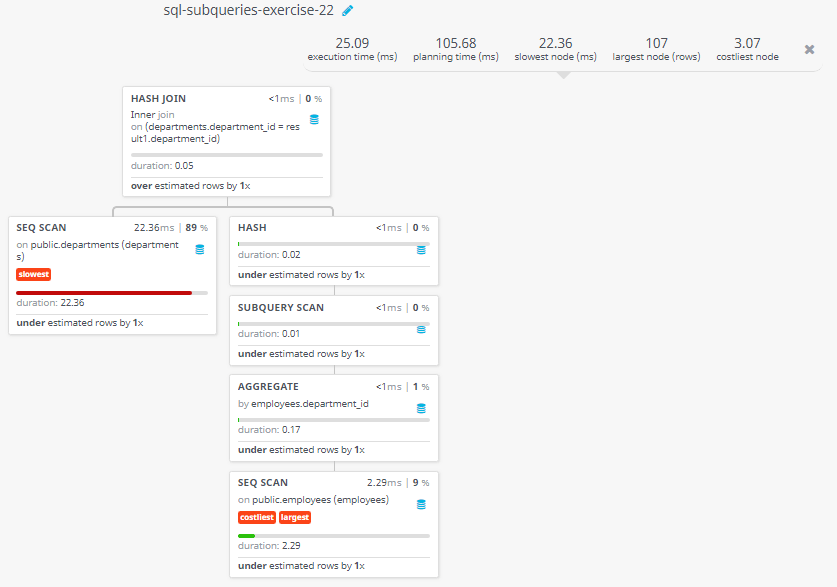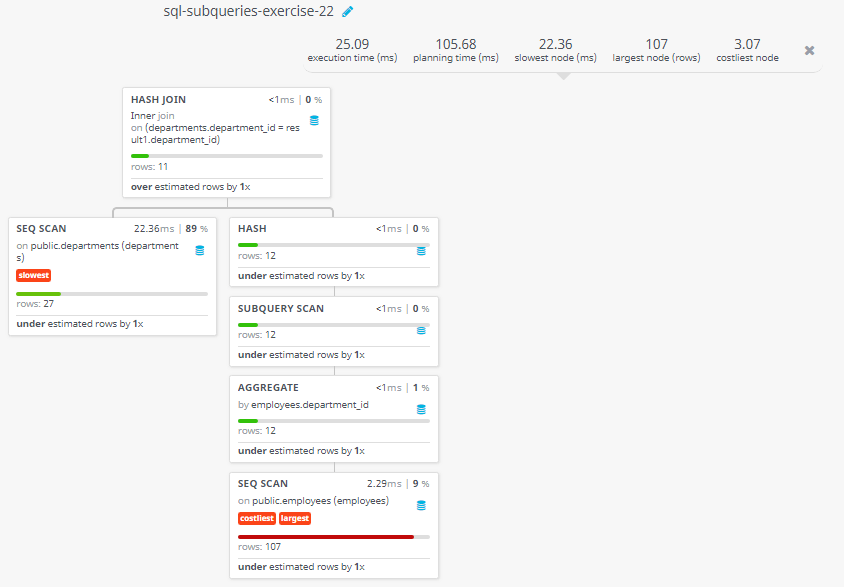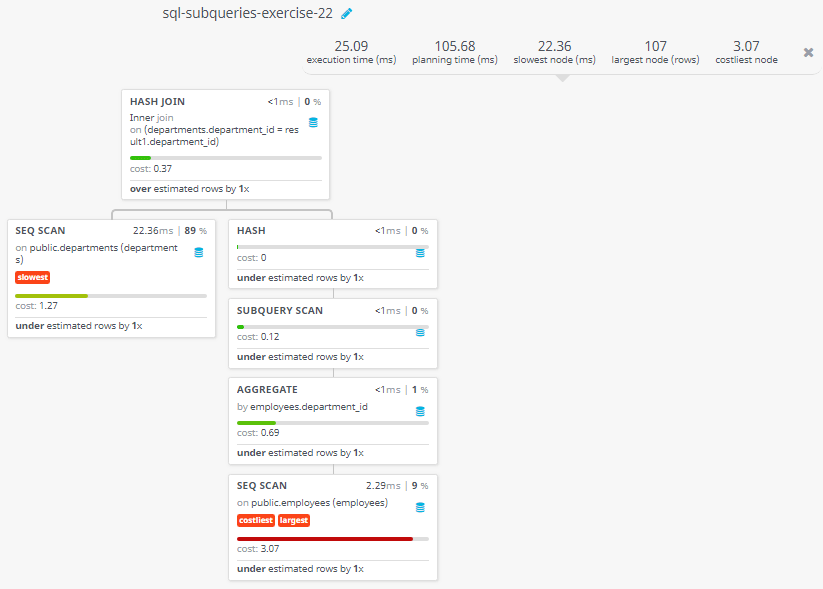SQL Exercises: Departments which contains at least one employee
From the following table, write a SQL query to calculate total salary of the departments where at least one employee works. Return department ID, total salary.
Sample table: employees
+-------------+-------------+-------------+----------+--------------------+------------+------------+----------+----------------+------------+---------------+ | EMPLOYEE_ID | FIRST_NAME | LAST_NAME | EMAIL | PHONE_NUMBER | HIRE_DATE | JOB_ID | SALARY | COMMISSION_PCT | MANAGER_ID | DEPARTMENT_ID | +-------------+-------------+-------------+----------+--------------------+------------+------------+----------+----------------+------------+---------------+ | 100 | Steven | King | SKING | 515.123.4567 | 2003-06-17 | AD_PRES | 24000.00 | 0.00 | 0 | 90 | | 101 | Neena | Kochhar | NKOCHHAR | 515.123.4568 | 2005-09-21 | AD_VP | 17000.00 | 0.00 | 100 | 90 | | 102 | Lex | De Haan | LDEHAAN | 515.123.4569 | 2001-01-13 | AD_VP | 17000.00 | 0.00 | 100 | 90 | | 103 | Alexander | Hunold | AHUNOLD | 590.423.4567 | 2006-01-03 | IT_PROG | 9000.00 | 0.00 | 102 | 60 | | 104 | Bruce | Ernst | BERNST | 590.423.4568 | 2007-05-21 | IT_PROG | 6000.00 | 0.00 | 103 | 60 | | 105 | David | Austin | DAUSTIN | 590.423.4569 | 2005-06-25 | IT_PROG | 4800.00 | 0.00 | 103 | 60 | | 106 | Valli | Pataballa | VPATABAL | 590.423.4560 | 2006-02-05 | IT_PROG | 4800.00 | 0.00 | 103 | 60 | | 107 | Diana | Lorentz | DLORENTZ | 590.423.5567 | 2007-02-07 | IT_PROG | 4200.00 | 0.00 | 103 | 60 | | 108 | Nancy | Greenberg | NGREENBE | 515.124.4569 | 2002-08-17 | FI_MGR | 12008.00 | 0.00 | 101 | 100 | | 109 | Daniel | Faviet | DFAVIET | 515.124.4169 | 2002-08-16 | FI_ACCOUNT | 9000.00 | 0.00 | 108 | 100 | | 110 | John | Chen | JCHEN | 515.124.4269 | 2005-09-28 | FI_ACCOUNT | 8200.00 | 0.00 | 108 | 100 | .................... +-------------+-------------+-------------+----------+--------------------+------------+------------+----------+----------------+------------+---------------+
Sample table: departments
+---------------+----------------------+------------+-------------+ | DEPARTMENT_ID | DEPARTMENT_NAME | MANAGER_ID | LOCATION_ID | +---------------+----------------------+------------+-------------+ | 10 | Administration | 200 | 1700 | | 20 | Marketing | 201 | 1800 | | 30 | Purchasing | 114 | 1700 | | 40 | Human Resources | 203 | 2400 | | 50 | Shipping | 121 | 1500 | | 60 | IT | 103 | 1400 | | 70 | Public Relations | 204 | 2700 | | 80 | Sales | 145 | 2500 | | 90 | Executive | 100 | 1700 | | 100 | Finance | 108 | 1700 | ...... +---------------+----------------------+------------+-------------+
Sample Solution:
-- Selecting specific columns (departments.department_id, result1.total_amt) from the 'departments' table and a derived table (aliased as result1)
SELECT departments.department_id, result1.total_amt
-- Cross join between the 'departments' table and a derived table (result1) to combine their data
FROM departments,
-- Subquery to calculate the total salary for each 'department_id' in the 'employees' table, aliased as result1
(SELECT employees.department_id, SUM(employees.salary) total_amt
FROM employees
-- Grouping the data by 'department_id' to calculate the sum of salaries
GROUP BY department_id
) result1
-- Matching rows based on the 'department_id' between the 'departments' table and the result1 derived table
WHERE result1.department_id = departments.department_id;
Sample Output:
department_id total_amt 10 4400.00 20 19000.00 30 24900.00 40 6500.00 50 156400.00 60 28800.00 70 10000.00 80 304500.00 90 58000.00 100 51600.00 110 20300.00
N.B. : In certain instances not null is removed in table structure, so results may vary.
Code Explanation:
The said query in SQL that is used to retrieve the department ID and total salary amount for each department in the 'departments' table.
The query first uses a subquery to calculate the total salary for each department. The subquery selects the department ID and salary from the 'employees' table and groups the data by department ID. The sum of the salaries for each group is calculated and given an alias of "total_amt".
The outer query then joins the 'departments' table with the result of the subquery on the "department_id" column.
Visual Presentation:
Alternative Statements:
Using INNER JOIN:
SELECT d.department_id, SUM(e.salary) total_amt
FROM departments d
JOIN employees e ON d.department_id = e.department_id
GROUP BY d.department_id;
Using EXISTS subquery:
SELECT d.department_id,
SUM(e.salary) total_amt
FROM departments d
JOIN employees e ON d.department_id = e.department_id
GROUP BY d.department_id
HAVING SUM(e.salary) > 0;
Using LEFT JOIN:
SELECT d.department_id, COALESCE(SUM(e.salary), 0) total_amt
FROM departments d
LEFT JOIN employees e ON d.department_id = e.department_id
GROUP BY d.department_id
HAVING COALESCE(SUM(e.salary), 0) > 0;
Go to:
PREV : Employees whose salary is more than 3700.
NEXT : Employees whose job title is ST_MAN, IT_PROG.
Practice Online
Query Visualization:
Duration:
Rows:
Cost:
Contribute your code and comments through Disqus.
What is the difficulty level of this exercise?
Test your Programming skills with w3resource's quiz.



